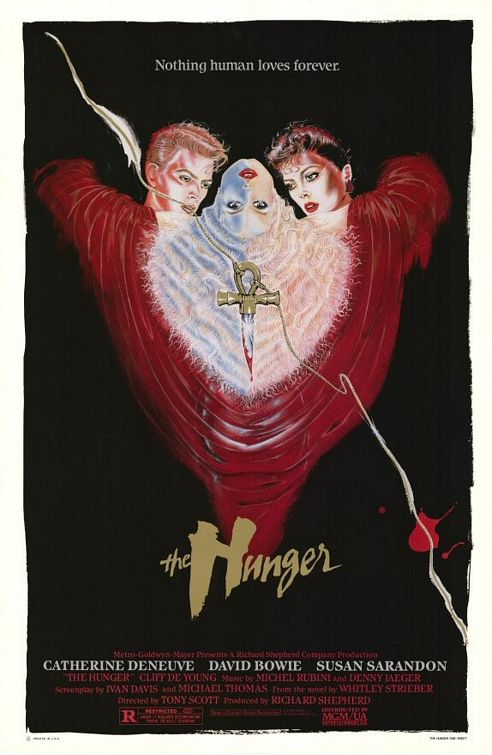
Despite being a mainstream, upscale version of the European erotic horror flicks of the 1970s, Tony Scott’s The Hunger goes to unnecessary lengths to distance its vampires from the creatures already well-established in the public’s consciousness. Plot points hinge on Miriam and John Blaylock, our stylish vampiric duo, being seen in reflections and photographs, of being out during the daytime, and most notably, of not being immortal. Some are immortal, apparently, or perhaps there is just a complicated system of mortality involved in vampirism that the film never feels any need to explain. At any rate, these are thoroughly modern vampires, who listen to Bauhaus and wear lots of leather and keep a hefty supply of Chanel lipstick in Rouge Passion on hand at all times.
Starring Catherine Deneuve as Miriam and David Bowie as her lover John, the story joins the pair as they trawl the dark disco clubs of New York City, looking for their next victims. They have a distinct type, and find a hip young couple, played by John Stephen Hill and the fabulous Ann Magnuson, to take home with them. A little fooling around in the dark and a couple of well-placed slashes to the neck later, and Miriam and John are fed and happy, ready to go another week before doing it again.
There’s just one problem: John, turned by Miriam sometime back in the 17th century, is aging rapidly, and there seems to be no way to stop it. Enter Dr. Sarah Roberts (Susan Sarandon), a local researcher who has discovered a link between progeria, aging and sleep, and who both John and Miriam contact in order to try to save him. Truth be told, it’s not entirely clear why Miriam approaches Sarah; in fact, it’s quite possible that she was just attracted to her, and already had eyes on her to replace John when he inevitably died.
Directed by Tony Scott, The Hunger is probably best known today as being a box office dud, decried by most critics at the time for being all MTV style and no substance. Some of the same criticism was lobbed at Scott’s brother Ridley for Blade Runner a year earlier, though less often, and of course, Blade Runner didn’t steal its visuals from The Hunger, but The Hunger certainly steals some visuals from Blade Runner. It also steals visuals from music videos and commercials and some of the more high-end fashion advertising of the day, and to such a degree that the plot, or at least what there is of it, is almost completely subsumed underneath the high-polished shine of the 1980s.
The Hunger also indulges in the same kind of conservative sexual politics that hinders so many films of the 1980s, films where a healthy sex life, especially a non-hetero one, leads to all sorts of dangers. Much is made of Miriam’s bisexuality, and Hollywood has the same relationship with bisexuals as Zapp Brannigan has with Neutrals: with heterosexuals, you know where they stand, but with bisexuals, who knows?
What The Hunger really excels at is self-conscious filmmaking presented to an audience without even a hint of subterfuge. Blood is never just splashed in frighteningly beautiful patterns in The Hunger; rather, carefully arranged blood splatter slowly fades into view through an obvious special effect. It’s not that both John and Sarah have the same habit of running their hand through their hair, but that the camera is perfectly placed each time it happens, to capture it in the exact same way, repeatedly, so often that even the most casual viewer will be thinking more about the cinematographer than about the characters on screen. This refusal to hide the technical aspects of the film go too far, sometimes, such as in the scenes with John in his aging makeup, which is apparently too delicate for Deneuve to touch, resulting in some awkward staging where she’s meant to be holding Bowie but can’t for fear of ruining the scene.
Misstep aside, the point is made. It’s as though The Hunger is offering itself up to the audience like a willing sacrifice, baring its gears and internal organs and not even trying to keep up the illusion of reality. It’s an interesting concept for those of us watching the film today, but in the 1980s, this kind of high-concept mainstream aesthetic was greeted with cynicism. Justin Wyatt writes in High Concept: Movies and Marketing in Hollywood that the overt perfection of the images in high-concept films like The Hunger mirrors the same style of unattainable perfection in 1980s advertising, and notes that, not coincidentally, director Tony Scott got his start in television commercials.
Where some see this offering-up by the film as an attempt to create a parallel between the creation and consumption of art versus the creation and (metaphorical) consumption of human emotion, Wyatt sees it instead as a deliberate means to draw attention to the formal composition of the film. In turn, this creates imagery that could be easily extracted for studio marketing purposes, though as Wyatt aptly notes, the marketing for this particular film is pretty dire; the poster alone is a real mess, and the publicity photos looked like fashion shoots for Vogue, with most shots bearing no resemblance to the film at all.
Bowie gives a really terrific performance as John, especially in the scenes where he, despite already being 300 years old, is desperate to survive. Deneuve is the beautiful, empty-eyed model she was hired to be, and Sarandon gives a solid performance, if not a bit obvious. The supporting cast is quite good, though not always used properly; silent film star Bessie Love in a cameo at the 17-minute mark was treated pretty poorly, for instance, and Rufus Collins is shoved so far into the background that even when he has lines you can barely see him.
However, on a pure entertainment level, The Hunger is not a bad film. The neo-Gothic visuals are as appealing as ever, and for those who miss the early 80s New Wave scene, this film is a must-see. Ignore the really bonkers ending that looks tacked on (spoiler alert: it was) and enjoy The Hunger’s slight but interesting commentary on love, commercialism and possession.
Warner Archive has released The Hunger on a MOD Blu-ray that includes commentary by Tony Scott and Susan Sarandon as well as subtitles and the theatrical trailer. The audio is terrific with good balance and nice bass that doesn’t overwhelm. The image is surprisingly grainy for a 1983 release, sometimes giving the film a sharp or “sparkly” look, but the color is amazing and the shadows rendered beautifully. For more tech spex, check out Blu-ray.com, which has screencaps.

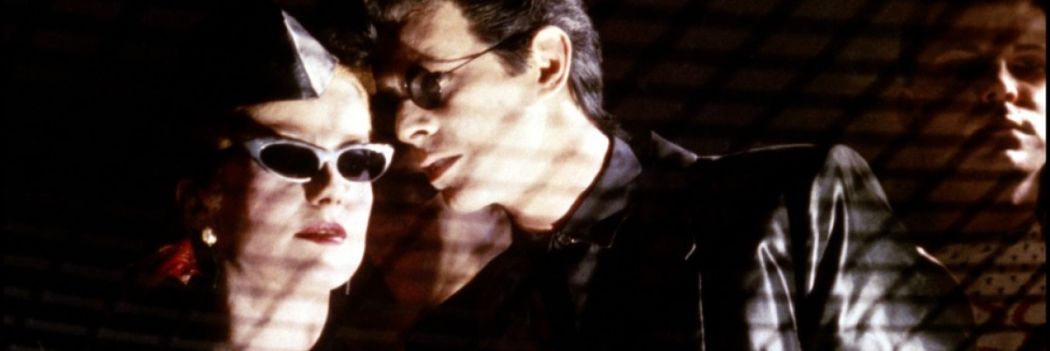
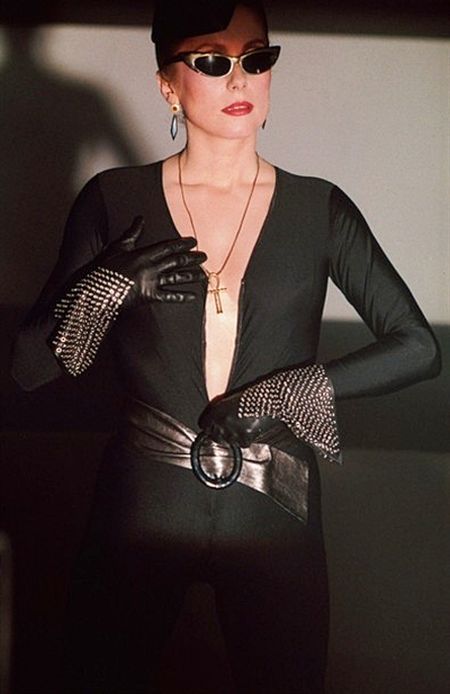

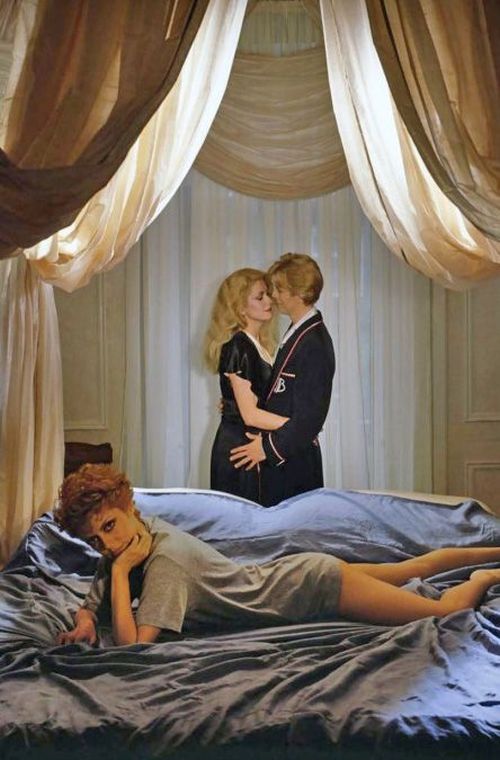
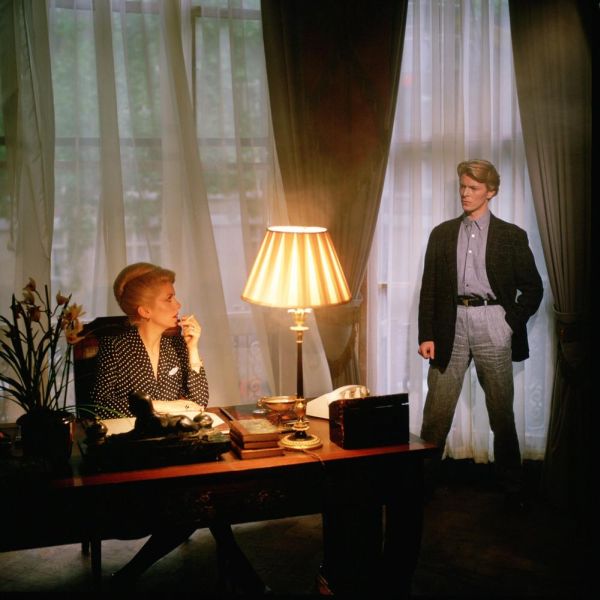
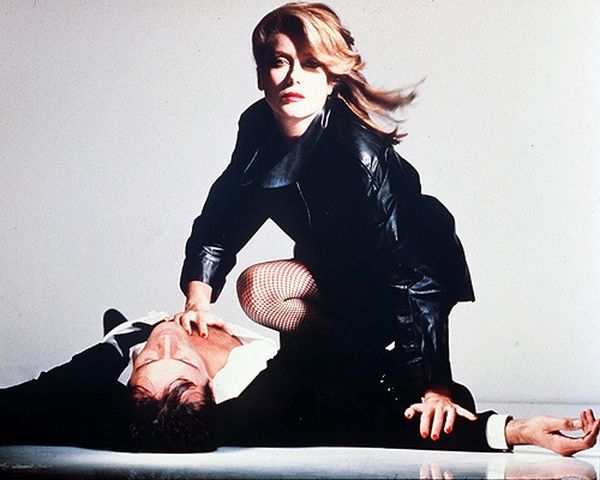
I actually saw this one when it first hit the theaters (so don’t blame this box office dud business on me) and I remember liking it because of its stylishness and the Deneuve-Sarandon romance. But revisiting it again a couple of months ago I kind of have to wonder what I saw in the film. Bowie is great, but the fact that his rapid aging process is never fully explained kind of grates on me, and the ending is pretty weak (Sarandon says they changed the ending to anticipate a sequel). Like you say, it’s pure entertainment…but it’s also no cake and lots of icing.